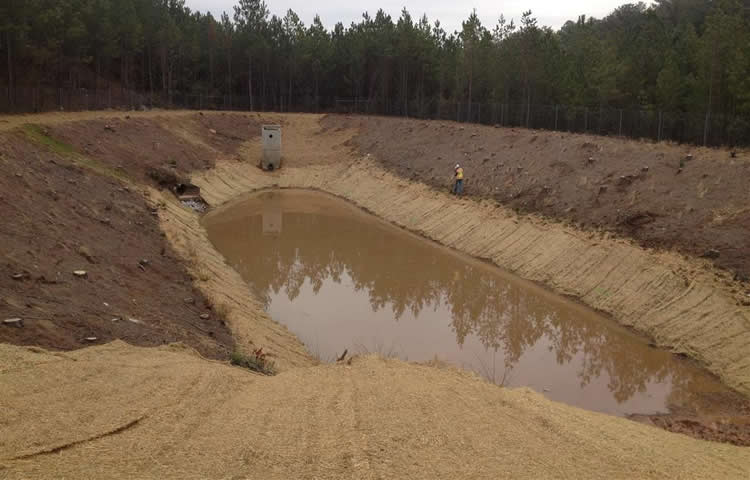Houston Retention Ponds
We can build a summer oasis just for you.
New ponds, old ponds … ponds for decoration, ponds for livestock … small ponds, big ponds … deep ponds, shallow ponds … It doesn’t matter to us, we can work with any pond!

Let us fashion a brand-new pond for you and give you that quintessential Texas view from your kitchen window. Or how about a pond that serves as a watering hole for your livestock? Or your own personal fishing pond?
Ponds are great because they are so versatile and fun. They can be functional, recreational, a joy to look at or all three at once. We can dig a pond to the dimensions you specify, build dirt up to create a berm, clean silt out of an older pond, repair an older pond, and more.
Houston Detention Ponds vs. Retention Ponds
Whether you need a detention pond or a retention pond depends mostly on personal preference and what your needs are. Do you want to have an area that is always holding water? Then a retention pond is what you need. Or do you need water to slowly soak back into the ground after collecting in the pond? In that case, you’ll want a detention pond.
That’s the main difference between the two: retention ponds hold water indefinitely (they retain or permanently hold the water), while detention ponds act like a temporary storage area for rainwater to prevent flooding (they detain or temporarily hold the water).
Both are useful for large areas of land that experience poor drainage after rainfall. With the land around the pond graded in such a way that the water naturally flows toward it, detention and retention ponds collect large amounts of water and reduce flooding and erosion. A retention pond can be maintained as a “living” pond with fish and aquatic plants, so long as there is enough rainfall to keep it full of a minimum amount of water. A detention pond can be part of a natural irrigation plan, holding back rainwater and slowly releasing it into the ground, acting much like a berm.
Who Benefits Most From a Detention or Retention Pond?
Because these ponds control storm water, they are typically large. Therefore it’s usually beneficial for the ponds to be situated on large tracts of land. Even if your backyard is big, there’s a good chance that the water from your neighbors’ yards will also flow into your pond, which may not always be a good thing. A customized strategy is best if you don’t have much space to work with. Contact us and we can get a plan together for you.
However, retention ponds benefit ranchers, as they provide a water source for livestock in areas where it’s impractical or costly to bring water to the herd. The pond will quickly pay for itself in water savings alone. Likewise, farmers benefit from detention ponds by incorporating them into areas as part of a natural irrigation strategy, ensuring that sensitive plant roots are not inundated with standing water after a heavy rain while also keeping the soil moist as water slowly leaches into the surrounding area.
Detention ponds are also useful alongside fragile streams or mountainsides, where erosion is a threat. For example, a detention pond placed between a slope and a stream will “catch” rainwater rolling down the hill before it reaches the stream. The banks of the stream will be protected from erosion damage that occurs with flood water. The detention pond allows the water to enter the waterway in a controlled manner.
Municipalities also need detention ponds alongside roadways and in residential areas to control the flow of stormwater.
Cost of a Detention Pond or a Retention Pond in Houston Texas
The cost of your detention pond project (or the cost of your retention pond, of course) depends on a few factors such as the size of the pond and the location where it will be dug. However, in many cases if the water from a pond is being repurposed, the pond will pay for itself very quickly. You will have access to hundreds of gallons of free water every time it rains, which can be used as a watering hole for your livestock or to water your crops. And that’s nothing to sneeze at, since water isn’t cheap! Ponds meant to decrease flooding or to control storm water can also save money in flood damage repair. In short, a retention or detention pond is a sound investment. Contact us for a custom estimate.
Deciding Where to Place a Pond in Houston, Texas
In order to make the most of your pond, it needs to be placed in an area that has an appropriate water source and drainage area, as well as the correct soil type.
First, the drainage area needs to be assessed to help determine the size of the pond. The drainage area refers to the amount of surface area (in terms of acres or square miles) that feeds rainwater into the pond. If the drainage area is too large, the pond will easily overflow. If the drainage are is too small, the pond might dry up too easily.
But rainwater isn’t the only source of water that can fill a pond, and the other sources need to be considered as well. If the water table in the area is generally high, a pond can be dug in a low-lying area and naturally stay as full as the water table. However, one of the more common sources of water for a pond is overland drainage, which means that the pond is placed in a low-lying area because water will automatically flow downhill into the pond.
The surrounding land doesn’t have to naturally lead to a convenient spot for a pond, though. The surrounding area can be manipulated to divert water flow, essentially guiding rain water into the pond. This is the perfect solution to many areas that flood easily after rain.
Finally, the soil structure needs to be analyzed for impermeability. To maintain a retention or recreational pond, the soil needs to prevent water from passing through. Water will be lost through evaporation anyway, but if the soil isn’t right, it will be like having a pool that has sprung a leak. It will be impossible to keep the water at a certain level. On the other hand, if you want to have a detention pond, which will hold the water temporarily but eventually allow the water to pass through, an impermeable soil is inappropriate. Generally, a soil that is mostly clay is best for maintaining water levels, whereas soils with a greater sand composition are useful for detention ponds. If the soil on site is not correct, it can be amended, although bringing dirt in from outside is just as practical.
How to Dig a Pond in Houston
If you want to dig a small pond (about 3 feet deep or less) and have soil that’s pretty easy to stick a spade in, you can certainly dig your pond on your own. But digging is not really the hard part. Selecting the right location is usually trickier, as is making sure that the surrounding area is graded in a way that will allow rainwater to flow into the pond. For a deeper pond or one that will have a large surface area, digging machines will make the job that much easier, and faster. After digging to the desired depth, new soil may be needed to create the impermeable basin. Then the base will need to be tamped down.
For best results, particularly with large ponds or those meant to serve a special purpose, call a professional.

